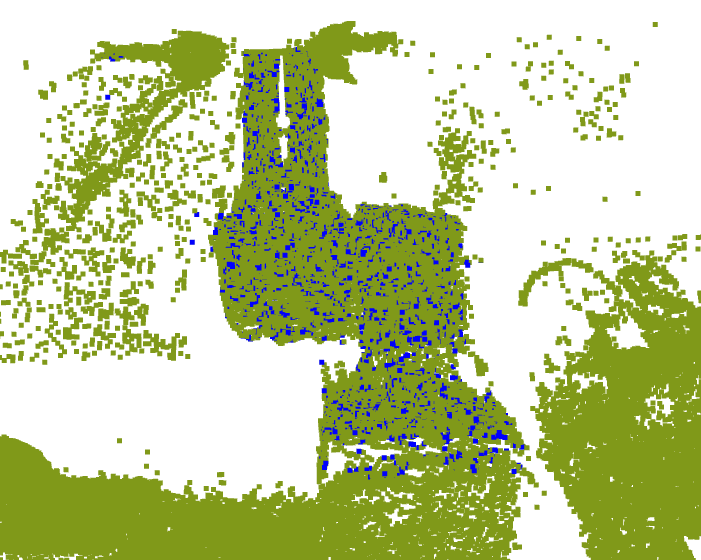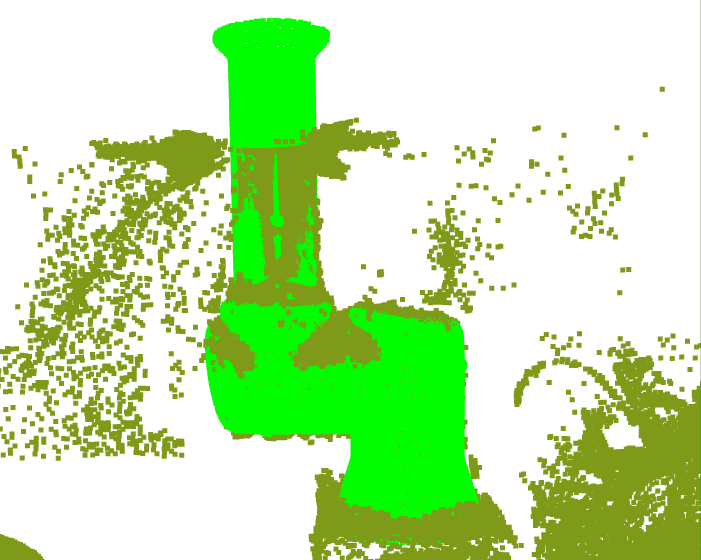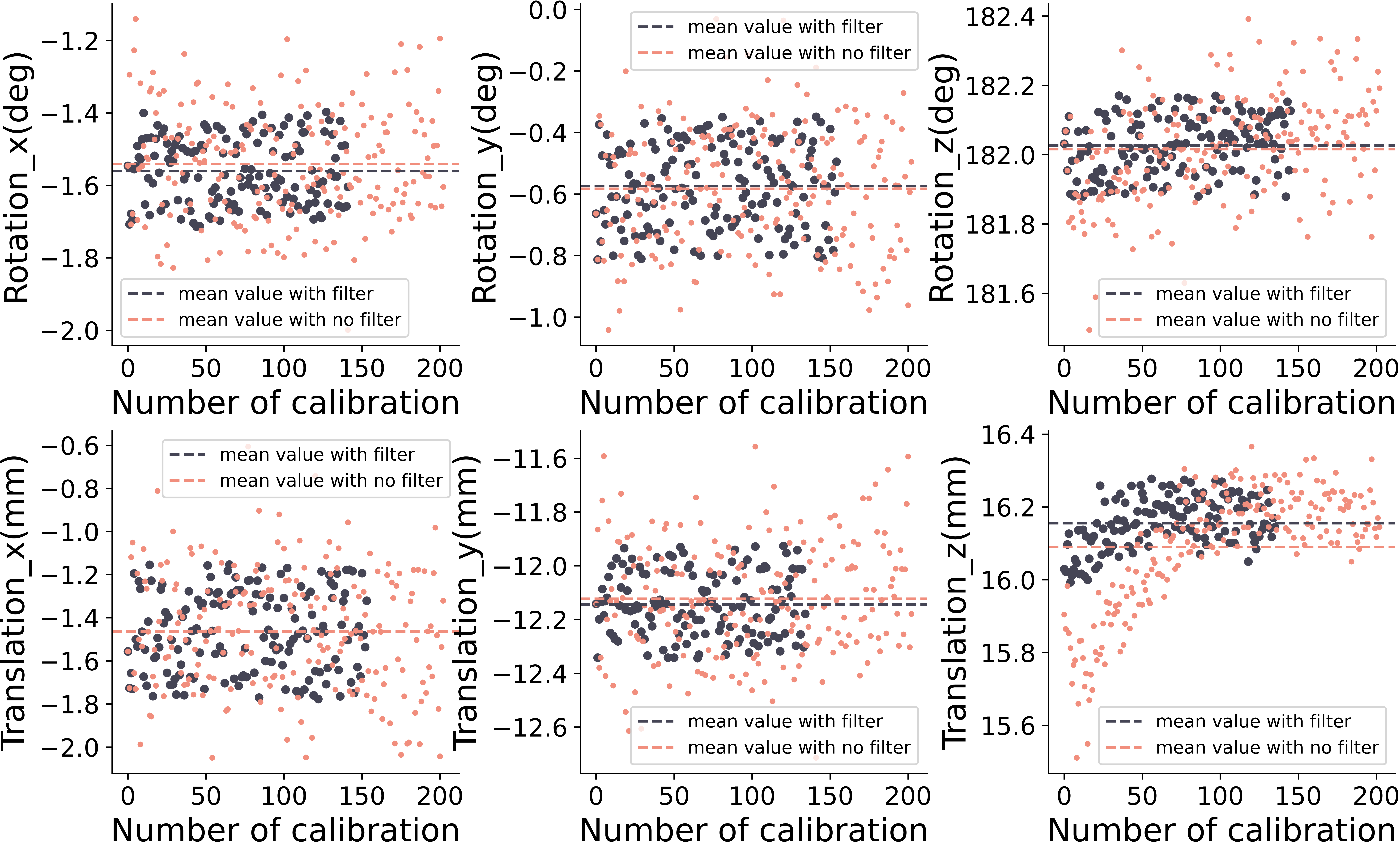Paper Link: Here
Welcome to our project: Look at Robot Base (LRBO): Hand-eye Calibration
Our proposed method has THREE features:
- [EASY] For both eye-in-hand and eye-to-hand calibration, it doesn't require any additional calibration objects (No calibration objects), such as a chessboard or something like that.
- Hand-eye calibration can be done with only 3D point clouds.
- [FAST] The processing time could be fast (<1 sec) and the result is as accurate as other 3D vision-based methods.
Overall, it is a Fully Automatic robot hand-eye calibration based on 3D vision (point cloud).
The overall requirement is as follows(Please install them following the official guideline):
- PRADATOR: a 3D registration for low-overlap point clouds.
- PVRCNN/PVRCNN++: a 3D detection module for the robot base detection.
- The utilization for both above can be seen here.
However, to utilize our solution in our project quickly, here contains the guideline where the performance can not be guaranteed but in simple cases, it should be working.
To be honest, the above libraries are generally not 'must required' if you look at the pipeline as shown below. The goal is to find the orientation and direction of the robot base in view of the camera (3D camera), so that we can estimate the transformation between the robot base and the camera directly and easily. To be honest, the above libraries are generally not 'must required' if you look at the pipeline as shown below. The goal is to find the orientation and direction of the robot base in view of the camera (3D camera), so that we can estimate the transformation between the robot base and the camera directly and easily. The other transformation could be solved by the classical forward kinetic model.
In this repository, we will try to provide some tutorials and videos that give more details and the performance of our method. We believe that our proposed method has more potential to be used in the industrial field and applications such as vision-based grasping, assembly and quality inspection.
Hand-eye calibration is a fundamental task in vision-based robotic systems, referring to the calculation of the relative transformation between the camera and the robotic end-effector. It has been studied for many years. However, most methods still rely on external markers or even human assistance. This paper proposes a one-click and fully automatic hand-eye calibration method using 3D point clouds obtained from a 3D camera. Our proposed hand-eye calibration is performed much faster than conventional methods. This is achieved by the learning-based detection and registration of the robot base. In addition, the calibration is performed automatically using only one native calibration object, the robot base, which simplifies the process. Our proposed method is tested for repeatability and accuracy through a series of experiments.
The pipeline for our proposed method is shown below (will be published soon), where eye-in-hand calibration is taken as an example because it is more complex compared to eye-to-hand calibration. The estimation of the transformation matrix between the camera and the robot base is a common problem for them.
The dataset generation for the robot base is elaborated in paper.
Here we captured more than a series of point clouds from a 3D camera. The raw point clouds are green and the Regions of Interest (ROIs) are blue (they are the same size, so they might be a bit hard to see :).
These ROIs that extracted from raw point clouds is aligned with a model of robot base (actually is a point cloud as well), the registration result is shown below
In fact, we can perform a hand-eye calibration with only a single point cloud. Therefore, we executed hundreds of calibrations (eye-in-hand calibration) during each data acquisition. The result is shown below, where the camera image is displayed close to the end-effector.
The video and tutorial are coming soon.
By measuring the variability in the results, repeatability experiments can provide insight into the stability and robustness of the calibration method and ensure that the results are not merely due to random fluctuations. Therefore, more than 200 hand-eye calibration were conducted in 300 sec (surprise?!). The results are shown below.
Two types of testing are performed, called static testing and dynamic testing. Static testing is considered the ground truth.
| Method | Position error (mm) | Rotation error (deg) | Runtime | Camera Type |
|---|---|---|---|---|
| Ours | X: 1.874 Y:1.092 Z: 0.303 | 0.391 | 1.5 + 5 (move) | ToF Camera |
| Ours | X: 1.159 Y:0.697 Z: 1.025 | 0.994 | <1 + 5 (move) | Structured of Light Camera |
PREDATOR, a learning-based point cloud registration framework is applied in our project. In addition, the PV-RCNN++ as a 3D detection module to provide a rough location of the robot base is employed in our method. According to the evaluation result and experiments, their performance is excellent compared with other conventional registration methods (more details in the paper).
We here utilized real-world data to train these framework. The trained model in terms of PREDATOR and PV-RCNN++ can be downloaded as follows:
- Detection/Trained model: This model can be used for UR3e and UR5e robot base detection task
- Registration/Trained model: This model can be used for robot base registration. A model of robot base can be obtained from Here.
If you found it is helpful, please cite:
@misc{li2023look,
title={Look at Robot Base Once: Hand-Eye Calibration with Point Clouds of Robot Base Leveraging Learning-Based 3D Vision},
author={Leihui Li and Yixiong Du and Xingyu Yang and Riwei Wang and Xuping Zhang},
year={2023},
eprint={2311.01335},
archivePrefix={arXiv},
primaryClass={cs.RO}
}
This project is maintained by @Leihui Li, please be free to contact me if any questions.




